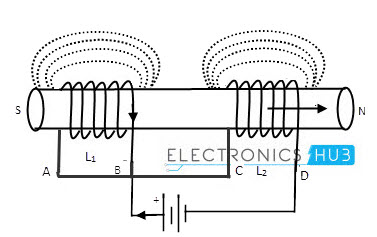Any device which has the property of inductance can be called an inductor. Usually inductor is built in the form of a coil with copper material around the core of a magnetic (iron) or nonmagnetic medium (like air). Inductors may be connected in series or parallel configuration depends on performance required by the circuit. These combinations are used to design more complex networks. The total inductance of a circuit depends on the way inductors are connected may be in either series or parallel. In addition, the way inductors are connected such that one inductance has no effect on other also varies the total inductance as compared with effect of magnetic coupling between inductors. Therefore, inductors are arranged on the basis of their mutual inductance or magnetic coupling in series or parallel combinations.
Inductors Connected in Series
Assume that inductors connected in the circuit do not have any coupling between them. This implies that there are no flux lines from one inductor linking with another, and hence there will be no mutual flux between the coils. The end to end connection of two or more inductors is called “series connection of inductors”. In this connection the inductors are connected in series so the effective turns of the inductor increases. The series connection of the inductors is shown in below diagram
The inductance of series connected inductors is calculated as the sum of the individual inductances of each coil since the current change through each coil is same.
This series connection is similar to that of the resistors connected in series, except the resistors are replaced by inductors. If the current I is flowing in the series connection and the coils are L1, L2, and so on, the common current in the series inductors is given by ITotal = IL1 = IL2 = IL3. . . = In If the individual voltage drops across each coil in this series connection are VL1, VL2, V¬L3, and so on, the total voltage drop between the two terminals VT is given by VTotal = VL1 + VL2 + VL3…. + Vn As we know that the voltage drop can be represented in terms of self inductance L, this implies V = L di/ dt. This can also be written as LT di/dt = L1 di/dt + L2 di/dt + L3 di/dt + . . . + Ln di/dt Therefore the total inductance is LTotal = L1 + L2 + L3 + ….. + Ln This means the total inductance of the series connection is the sum of individual inductances of all inductors. The above equation is true when there is no mutual inductance affect between the coils in this series configuration. The mutual inductance of the inductors will make a change in value of the total inductance in the series combination of inductors. Assume that there are two inductors connected in series with the alternating voltage source which can generate a varying current in the circuit as shown in the above figure. If there is no mutual inductance in the circuit, then the total inductance is given as LT = L1 + L2 It is important to remember that the total inductance is always greater than the largest inductor in the series arrangement of inductors.
Inductors Connected in Series Example
Ex 1: If a circuit has 3 inductors of 60 Henry, 30 Henry and 20 Henry connected in series, what will be the total inductance of the series? Sol: We know that the formula for total inductance of series, LTotal = L1 + L2 + L3 + ….. + Ln Given that L1 = 60 Henry L1 = 30 Henry L1 = 20 Henry The total inductance, LTotal = 60 + 30 + 20 = 110 Henry.
Mutually Connected Inductors in Series
Now consider that inductors are connected such that magnetic field of one coil affects the other. When two or more inductors are connected in series, then the inductance of one inductor will be affected by the magnetic field produced by the other coil. This is called mutual inductance and the coils are called “Mutually connected inductors”. This mutual inductance may increase or decrease the total inductance of the series circuit. The factor that affects the mutual inductance of a series connected of inductors is the distance between the coils and their orientation. The mutually connected inductors can coupled in two types
- Cumulatively coupled or Series Aiding
- Differentially coupled or Series opposing
Cumulatively Coupled Inductors in Series
If the magnetic fluxes produced by the inductors are in the same direction to the flow of current through them, then the coils are known as “Cumulatively coupled”. In this series aiding or cumulative coupled circuit, the current enters or leaves the terminals of coils at any instant of time are in the same direction. The figure below shows the connection of two inductors in series aiding arrangement.
If we pass the current through the cumulatively coupled coils (between the nodes A & D) in the same direction, the voltage drop of each individual coil will affect the total inductance of the series. Let self inductance of the coil-1 is L1, self inductance of the coil-2 is L2 and the mutual inductance is M between coil 1 and coil2. Self induced emf in coil-1 is e1 = – L1 di/ dt Mutual induced emf in coil-1 due to change of current in coil-2 is eM1 = – M di/ dt Similarly, Self induced emf in coil-2 is e2 = – L2 di/ dt Mutual induced emf in coil-2 due to change of current in coil-1 is eM2 = – M di/ dt Therefore, total induced emf in the series aiding circuit is given as e = – L1 di/ dt– L2 di/ dt– 2M di/ dt = – (L1+ L2 + 2M) di/ dt If LT is the total inductance of the circuit, the total induced emf will be equivalent to e = – LT di/ dt Substituting in the above equation, we get – LT di/ dt = – (L1+ L2 + 2M) di/ dt Therefore, LT = (L1 + L2 + 2M) Ex: If two coils of inductance 70 mH and 30 mH are connected in series, then find the total cumulative inductance of the series connected inductors. Consider the mutual inductance of the combination of the two coils is 40 mH. Sol: Given that, L1 = 70 mH L2 = 30 mH M = 40 mH Applying the formula for cumulatively connected inductors, LT = L1 + L2 + 2M LT = 70 + 30 + 2 (40) = 100 + 80 =180 mH Therefore the cumulative inductance of the coil is 180 milli Henry.
Differentially Coupled Inductors in Series
If the magnetic fluxes produced by the inductors are in the opposite direction to each other, then the coils are known as “Differentially coupled”. In this differential coupled or series opposition connection, the current enters or leaves the terminals of coils at any instant of time are in the opposite direction. The figure below shows the connection of two inductors in series opposition arrangement.
In differentially coupled coils, the magnetic flux fields may produce in same direction or opposite direction. Let the self inductance of the coils are L1 and L2 and the mutual inductance is M. Here mutual inductance will be aided to each coil self inductance due to the circuit configuration. Therefore, total induced emf in the series opposing circuit is given as e = – L1 di/ dt– L2 di/ dt + 2M di/ dt = – (L1+ L2 – 2M) di/ dt If LT is the total inductance of the circuit, the total induced emf will be equivalent to e = – LT di/ dt Substituting in the above equation, we get – LT di/ dt = – (L1+ L2 – 2M) di/ dt Therefore, LT = (L1 + L2 – 2M) Ex: If two coils of inductance 70 mH and 30 mH are connected in series, then find the total differential inductance of the series connected inductors. Consider the mutual inductance of the combination of the two coils is 40 mH. Sol: Given that, L1 = 70 mH L2 = 30 mH M = 40 mH Applying the formula for differentially connected inductors, LT = L1 + L2 – 2M LT = 70 + 30 – 2 (40) = 100 – 80 = 20 mH Therefore the Differential inductance of the coil is 20 milli Henry.
Summary
An inductor is a passive element which is used in electronics circuits for storing energy as magnetic flux. Inductance is measured in Henry. The dissipation amount of actual power with the current flow in the circuit is called “Inductive reactance”. It is measured in ohms. XL = 2 f L Self inductance is the property of an electric circuit or a loop in which its own magnetic field opposes any change in current Mutual inductance is the ability of an inductor that causes to induce emf in another inductor placed very close to it when current in first inductor changes. The end to end connection of two or more inductors is called “series connection of inductors”. The formula for total inductance in series is LT = L1 + L2 The total inductance of the series connected inductors is always greater than the largest inductor in that series. If the magnetic fluxes produced by the inductors are in the same direction to the flow of current through them, then the coils are known as “Cumulatively coupled”. LT = L1 + L2 + 2M If the magnetic fluxes produced by the inductors are in the opposite direction to each other, then the coils are known as “Differentially coupled”. LT = L1 + L2 – 2M
Comment * Name * Email * Website
Δ








![]()